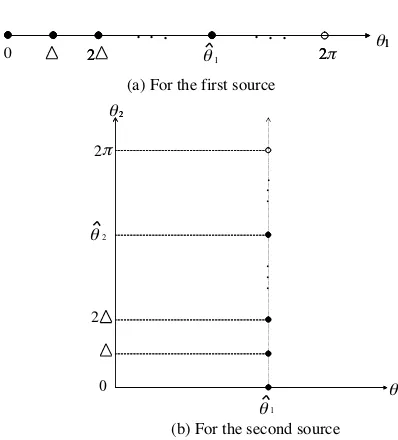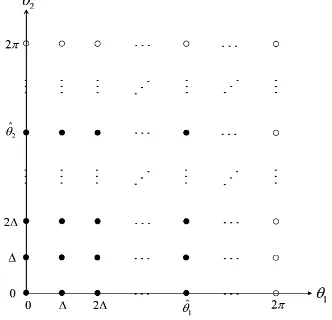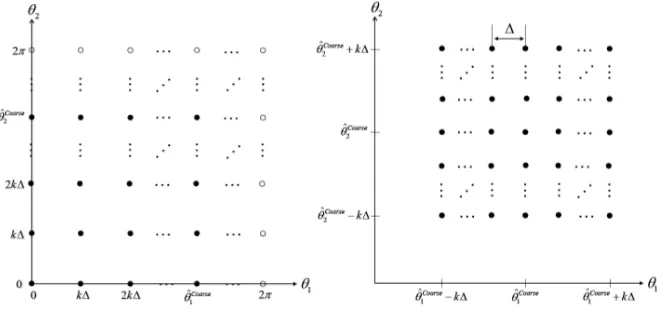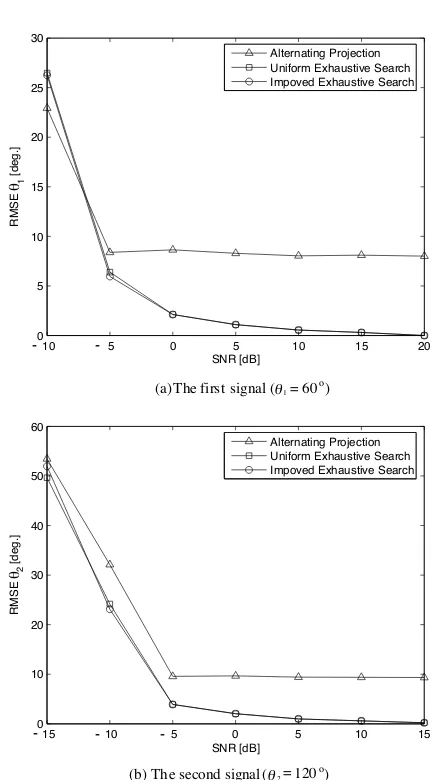ON INITIALIZATION OF ML DOA COST FUNCTION FOR UCA
J.-H. Lee and S.-H. Jo
Department of Information and Communication Engineering Sejong University
Seoul 143-747,Korea
Abstract—Maximum likelihood (ML) direction-of-arrival (DOA) estimation is essentially an optimization of multivariable nonlinear cost function. Since the final estimate is highly dependent on the initial estimate,an initialization is critical in nonlinear optimization. Alternating Projection (AP) initialization has been proposed as computationally efficient method for the initialization of the ML DOA cost function. In this paper,we propose a multi-dimensional (M-D) search scheme of uniform exhaustive search and improved exhaustive search. Improved exhaustive search is used to reduce the computational load of uniform exhaustive search. In the improved exhaustive search algorithm,the two-step procedure is applied to reduce the computational load of the uniform exhaustive search initialization scheme. In numerical results,it is shown that the performance of the proposed scheme is better than that of AP initialization.
1. INTRODUCTION
Direction-of-arrival (DOA) estimation [1–6] is an important task for wireless communications and radar [7–30]. The maximum likelihood (ML) algorithm [31] gives a superior performance compared to other methods. However,the likelihood function is multi-variate and highly nonlinear,and therefore requires much computational load.
To improve the performance of initialization in the viewpoint of RMSE (Root-mean-square error) of an initial estimate,we propose exhaustive M-D (multi-dimensional) search.
The paper is organized as follows. In Section 2,the data model for DOA in uniform circular array (UCA) is formulated and maximum-likelihood estimation is briefly described. Next,we propose uniform exhaustive search method and improved exhaustive search method in Section 3. In Section 4,simulation results are given to compare the performance of three different algorithms. Our concluding remarks are given in Section 5.
2. PROBLEM FORMULATION
2.1. Array Signal Model
It is assumed thatLnarrowband sources from far fields in the directions
of Θ = [θ1, . . . , θL] are impinging on the array consisting of M
antennas. The received signals can be modeled as
x(t) =A(Θ)s(t) +n(t) (1) where A(Θ) = [a(θ1), . . . , a(θL)] is array manifold, s(t) =
[s1(t), . . . , sL(t)]T is the L source signals at time t,and n(t) is the
additive white Gaussian noise which is not correlated to the signals. 2.2. Uniform Circular Array
We assume a uniform circular array (UCA) with identical antennas and uniform spacingdas shown in Fig. 1 whereθis the azimuth angle,ris
o r x
0
#1 # 2 #m
#M d
o r x
#1 # 2 #m
#M d
θ θ
the radius of the array,and θ0 = 2π/M is the angle between adjacent elements. φis elevation angle measured from thez-axis. The response of the mth sensor to theith signal is given by
am(θi) =ejΨm(θi) (2)
whereψm is given by
ψm= 2π
r
λcos(θ−(m−1)θ0) (3)
and θi lies in [0,2π).
2.3. Maximum Likelihood Estimate
Assuming that the signals s(t) are deterministic and unknown sequence,the maximum likelihood estimate of the DOA vector Θ = [θ1, . . . , θL] is given by [8]
ˆ
Θ= arg max
Θ tr
PA(Θ)Rˆ (4)
where PA(Θ)=A(Θ)(A(Θ)HA(Θ))−1A(Θ)H is the projection oper-ator onto the space spanned by the columns of the matrix A(Θ),
ˆ
R = (1/N)Nt=1x(t)xH(t) is the sample covariance matrix and N
denotes the number of data snapshots. 3. INITIALIZATION ALGORITHM
Once initial estimates of L-DOA’s are available,(4) is a nonlinear
L-variable optimization problem. It can be solved via gradient based-Newton iteration.
3.1. Alternating Projection Initialization
AP (Alternating Projection) algorithm is one-dimensional (1-D) optimization. AP initialization started on solving (4) for the first DOA
ˆ
θ1 = arg max
θ1
tr
Pa(θ1)Rˆ
. (5)
Next,it is solved for the second source withθ1= ˆθ1: ˆ
θ2 = arg max
θ2
tr
P[a(θˆ1),a(θ2)]Rˆ
1
0 222 1 222 1
1 2
1
0
2
2
2 2 2
. . . . . .
θ π θ
θ
π
θ
θ θ
. . .
. . . (a) For the first source
(b) For the second source
Figure 2. The search range and the search increment of the alternating projection for two signals.
The same procedure is repeated for all Lsources : ˆ
θl = arg max θl
tr
P[a(θˆ1),a(θˆ2), ...,a(θˆ
l−1),a(θl)]
ˆ R
l= 1, . . . , L (7) We get all the initial estimates for all L sources Θˆ = [ˆθ1, . . . , θˆL].
Fig. 2 shows the search increment and the search range of AP algorithm for two signals (L = 2). In this paper,the computational load KAP
denotes the number of cost function evaluations for AP initialization, which is given by
KAP =L·
2π
∆
. (8)
whererounds an argument towards plus infinity. 3.2. Uniform Exhaustive Search Initialization
Figure 3. The search range and the search increment of the uniform exhaustive search for two signals.
ˆ
θ1, . . . ,θˆL
= arg max
θ1, ..., θL
tr
P[a(θ1), ...,a(θL)]Rˆ
(9) where the search range for each source is [0,2π),and the search increment is ∆. To be more specific,it isL-Dimensional search,whose increment between adjacent search angle is ∆. The computational load of the scheme rapidly increases. At each search point ofL-D space,we evaluate cost function,and select the angle which maximizes the cost function. Fig. 3 shows the search increment and the search range of the uniform exhaustive search method for two signals (L = 2). The number of cost function evaluation,K,is given by
KUES =
2π
∆
L
. (10)
3.3. Improved Exhaustive Search Initialization
In this section,we explain the improved exhaustive search algorithm. We describe how to reduce the computational load of the uniform exhaustive search initialization scheme. The proposed scheme is based on two-step procedure of coarse search and fine search.
The coarse search can be formulated as follows: ˆ
θ1Coarse, . . . , θˆCoarseL = arg max [θCoarse
1 , ..., θCoarseL ]
tr
P[a(θCoarse
1 ), ...,a(θCoarseL )]
ˆ R
where the search range is [0,2π),and the search increment isk∆ which isktimes search increment of the uniform exhaustive search,∆. kis a constant that sets the coarse search increment. The second step,called the fine search,is a refinement procedure;
ˆ
θ1F ine, . . . , θˆF ineL
= arg max [θF ine
1 , ..., θLF ine]
tr
P[a(θF ine
1 ), ...,a(θF ineL )]
ˆ R
(12)
where the search range is around [ˆθ1Coarse, . . . , θˆCoarseL ],and the search increment is ∆. Fig. 4 shows the search increment and the search range of the improved exhaustive search method for two signals (L= 2). The number of cost function evaluation for the improved exhaustive search,
K,is given by
KIES =
2π
k∆
L
+ (2k+ 1)L (13)
kis dependent on ∆,therefore,kis determined based on the following criterion:
k= arg min
k KIES (14)
In Fig. 5,we compare the computational load of the improved exhaustive search with that of the AP and the uniform exhaustive search with respect to ∆. The optimum k value is determined on the basis of (13) and (14),and is dependent on ∆. The improved exhaustive search is much more efficient than the uniform exhaustive search in terms of computational load. The computational load of the improved exhaustive search is approximately two times that of the AP algorithm.
0.1 0.2 0.3 0.4 0.5 0.6 0.7 0.8 0.9 1 102
103 104 105 106 107 108
[degree]
# of cost evaluation
Alternating Projection Uniform Exhaustive Search Impoved Exhaustive Search
Figure 5. Comparison of the computational load with respect to ∆.
0 5 10 15 20 25
103 104 105
k
# of cost evaluation
Figure 6. The computational load of improved exhaustive search method with respect to k.
4. SIMULATION RESULTS
10 5 0 5 10 15 20 0
5 10 15 20 25 30
SNR [dB]
RMSE
1
[deg.]
Alternating Projection Uniform Exhaustive Search Impoved Exhaustive Search
(a) The first signal ( 1 60 )
15 10 5 0 5 10 15
0 10 20 30 40 50 60
SNR [dB]
RMSE
2
[deg.]
Alternating Projection Uniform Exhaustive Search Impoved Exhaustive Search
(b) The second signal ( 2 120 )
θ
θ = o
θ = o
θ
- -
--
-Figure 7. Comparison of DOA estimates with respect to SNR (Improved exhaustive search with k= 15 and ∆ = 0.8◦).
of Θ= [θ1, θ2] = [60◦,120◦]. It is assumed that two signals are fully correlated and that the power of the direct signal is greater than that of the reflected signal by 5 dB.
Figure 7 depicts the RMSE’s for two signals obtained by AP, uniform exhaustive search and improved exhaustive search,versus the SNR. As shown in the figures,both exhaustive search methods show better performance than AP algorithm,and the performance of the improved exhaustive search and that of the uniform exhaustive search are similar in terms of the estimation accuracy. But,the computational burden of the uniform exhaustive search is much greater than that of the improved exhaustive search.
5. CONCLUSION
In this paper,we propose the improved exhaustive search to reduce the computational load for the initialization of the ML DOA algorithm and to improve the accuracy of the initial estimate of ML DOA algorithm. The computational load of the improved exhaustive search is much less than that of the uniform exhaustive search method. Moreover, the performance of the improved exhaustive search is better than AP algorithm and is similar to the performance of the uniform exhaustive search. There is a tradeoff between the accuracy of estimation and the computational load.
ACKNOWLEDGMENT
This work was supported by the Korea Research Foundation Grant funded by the Korean Government (MOEHRD) (KRF-2005-003-D00261).
REFERENCES
1. Vorobyov,S. A.,A. B. Gershman,and K. M. Wong,“Maximum likelihood direction-of-arrival estimation in unknown noise fields using sparse sensor arrays,” IEEE Trans. Signal Processing, Vol. 53,34–43,Jan. 2005.
2. Chung,P.-J.,“Stochastic maximum likelihood estimation under misspecified numbers of signals,”IEEE Trans. Signal Processing, Vol. 55,4726–4731,Sep. 2007.
3. Marano,S.,V. Matta,P. Willett,and L. Tong,“Support-based and ML approaches to DOA estimation in a dumb sensor network,” IEEE Trans. Signal Processing,Vol. 54,1563–1567, Apr. 2006.
using vector sensor array in a multipath environment,” IEEE Trans. Signal Processing,Vol. 52,3096–3103,Nov. 2004.
5. Bethel,R. E. and K. L. Bell,“Maximum likelihood approach to joint array detection/estimation,”IEEE Trans. Aerospace and Electronic Systems,Vol. 40,1060–1072,Jul. 2004.
6. Abramovich,Y. I.,N. K. Spencer,and A. Y. Gorokhov,“Bounds on maximum likelihood ratio-part I: Application to antenna array detection-estimation with perfect wavefront coherence,” IEEE Trans. Signal Processing,Vol. 52,1524–1536,Jun. 2004.
7. Wang,S.,X. Guan,D. Wang,X. Ma,and Y. Su,“Fast calculation of wide-band responses of complex radar targets,” Progress In
Electromagnetics Research,PIER 68,185–196,2007.
8. Shi,Z.-G.,S. Qiao,K. S. Chen,W.-Z. Cui,W. Ma,T. Jiang, and L.-X. Ran,“Ambiguity functions of direct chaotic radar employing microwave chaotic colpitts oscillator,” Progress In
Electromagnetics Research,PIER 77,1–14,2007.
9. Chen,X.-J. and X.-W.Shi,“An expression for the radar cross section computation of an electrically large perfect conducting cylinder located over a dielectric half-space,” Progress In
Electromagnetics Research,PIER 77,267–272,2007.
10. Angell,A. J. and C. M. Rappaport,“Computational modeling analysis of radar scattering by clothing covered arrays of metallic body-worn explosive devices,” Progress In Electromagnetics
Research,PIER 76,285–298,2007.
11. Lee,K.-C.,J.-S. Ou,and C.-W. Huang,“angular-diversity radar recognition of ships by transformation based approaches — Including noise effects,” Progress In Electromagnetics Research, PIER 72,145–158,2007.
12. Vinogradov,S. S.,P. D. Smith,J. S. Kot,and N. Nikolic, “Radar cross-section studies of spherical lens reflectors,”Progress
In Electromagnetics Research,PIER 72,325–337,2007.
13. Atteia,G. E.,A. A. Shaalan,and K. A. Hussein,“Wideband partially-covered bowtie antenna for ground-penetrating-radars,”
Progress In Electromagnetics Research,PIER 71,211–226,2007. 14. Hussein,K. A.,“Effect of internal resonance on the radar cross
section and shield effectiveness of open spherical enclosures,”
Progress In Electromagnetics Research,PIER 70,225–246,2007. 15. Hebeish,A. A.,M. A. Elgamel,R. A. Abdelhady,and
A. A. Abdelaziz,“Factors affecting the performance of the radar absorbant textile materials of different types and structures,”
16. Chan,Y. K. and V. C. Koo,“An introduction to synthetic aperture radar (SAR),”Progress In Electromagnetics Research B, Vol. 2,27–60,2008.
17. Capineri,L.,D. Daniels,P. Falorni,O. Lopera,and C. Windsor, “Estimation of relative permittivity of shallow soils by using the ground penetrating radar response from different buried targets,”
Progress In Electromagnetics Research Letters,Vol. 2,63–71,2008. 18. Razevig,V. V.,S. I. Ivashov,A. P. Sheyko,I. A. Vasilyev,
and A. V. Zhuravlev,“An example of holographic radar using at restoration works of historical building,” Progress In Electromagnetics Research Letters,Vol. 1,173–179,2008.
19. Pinel,N.,C. Bourlier,and J. Saillard,“Forward radar propagation over oil slicks on sea surfaces using the ament model with shadowing effect,” Progress In Electromagnetics Research, PIER 76,95–126,2007.
20. Qiao,S.,Z.-G. Shi,T. Jiang,and L.-X. Ran,“A new architecture of UWB radar utilizing microwave chaotic signals and chaos synchronization,” Progress In Electromagnetics Research, PIER 75,225–237,2007.
21. Cui,B.,C. Wang,and X.-W. Sun,“Microstrip array double-antenna (MADA) technology applied in millimeter wave compact radar front-end,”Progress In Electromagnetics Research, PIER 66,125–136,2006.
22. Singh,A. K.,P. Kumar,T. Chakravarty,G. Singh,and S. Bhooshan,“A novel digital beamformer with low angle reso-lution for vehicle tracking radar,” Progress In Electromagnetics
Research,PIER 66,229–237,2006.
23. Alyt,O. M.,A. S. Omar,and A. Z. Elsherbeni,“Detection and localization of RF radar pulses in noise environments using wavelet packet transform and higher order statistics,”Progress In
Electromagnetics Research,PIER 58,301–317,2006.
24. El-Ocla,H.,“On laser radar cross section of targets with large sizes for E-polarization,” Progress In Electromagnetics Research, PIER 56,323–333,2006.
25. Chan,Y. K. and S. Y. Lim,“Synthetic aperture radar (SAR) signal generation,” Progress In Electromagnetics Research B, Vol. 1,269–290,2008.
26. El-Tokhy,M. A. and H. K. Mansour,“A 2.3-MW 16.7-MHz analog matched filter circuit for DS-CDMA wireless applications,”
modulus algorithm for wireless channel equalization,”Progress In Electromagnetics Research B,Vol. 4,237–248,2008.
28. Abdelaziz,A. A.,“Improving the performance of an antenna array by using radar absorbing cover,” Progress In Electromagnetics Research Letters,Vol. 1,129–138,2008.
29. Chen,Y.-L.,C.-L. Ruan,and L. Peng,“A novel ultra-wideband bow-tie slot antenna in wireless communication systems,”Progress In Electromagnetics Research Letters,Vol. 1,101–108,2008. 30. Azmi,P. and N. Tavakkoli,“Narrow-band interference suppression
in CDMA spread-spectrum communication systems using pre-processing based techniques in transform-domain,” Progress In Electromagnetics Research Letters,Vol. 3,141–150,2008.
31. Bresler,Y. and A. Macovski, “Exact maximum likelihood parameter estimation of superimposed exponential signals in noise,” IEEE Trans. Acoust., Speech, Signal Processing,Vol. 34, Oct. 1986.





